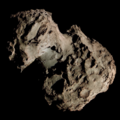 Comet 144P/Kushida 2008/2009 Appearance - Courtesy Hunter Wilson | |
| Discovery | |
|---|---|
| Discovered by | Yoshio Kushida |
| Discovery date | January 8, 1994 |
| Orbital characteristics | |
| Epoch | 2024-01-11 |
| Aphelion | 6.26 AU |
| Perihelion | 1.399 AU |
| Semi-major axis | 3.832 AU |
| Eccentricity | 0.6349 |
| Orbital period | 7.5 yr |
| Inclination | 3.932° |
| Last perihelion | August 30, 2016 [1] January 26, 2009 |
| Next perihelion | 2024-Jan-25 [2] |
| Jupiter MOID | 0.008 AU (1,200,000 km) [3] |
144P/Kushida is a periodic comet discovered in January, 1994, by Yoshio Kushida at the Yatsugatake South Base Observatory in Japan. This was the first comet discovery of 1994 and his second discovery within a month. It last came to perihelion on 25 January 2024, and brightened to about magnitude 10. [4]
| Date & time of closest approach | Mars distance (AU) | Sun distance (AU) | Velocity wrt Mars (km/s) | Velocity wrt Sun (km/s) | Uncertainty region (3-sigma) | Reference |
|---|---|---|---|---|---|---|
| 2119-May-17 11:19 ± 13 minutes | 0.049 AU (7.3 million km ; 4.6 million mi ; 19 LD ) | 1.68 AU (251 million km; 156 million mi) | 13.6 | 28.6 | ± 13 thousand km | Horizons |
Based on data gathered during the period of January 9–11, 1994 Syuichi Nakano calculated the date of perihelion to be 1993 December 5.33 and the distance of perihelion as 1.36 AU. The low inclination to the ecliptic suggested to Nakano that the comet could be a short period type. On January 14, 1994 Daniel W. E. Green confirmed Nakano's suggestion and published a short-period orbit on IAU Circular 5922. Based on 29 positions obtained during the period of January 9–13, Green determined a perihelion date of 1993 December 12.99, a perihelion distance of 1.37 AU, and an orbital period of 7.20 years.
Using over 300 positions obtained between January 7 and July 9, 1994 Patrick Rocher refined the calculations and determined the perihelion distance as 1.367 AU, the perihelion date as 1993 December 12.862, and the orbital period as 7.366 years.


